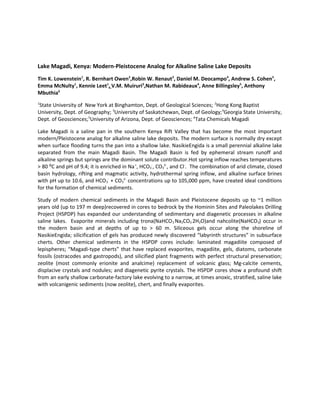Geological Society Of America Annual Session, Denver 2016 Abstract 2
•Download as DOC, PDF•
1 like•56 views
Report
Share
Report
Share

Recommended
Ocean acidification describes the changes in seawater chemistry that result from the uptake of anthropogenic carbon dioxide by the ocean. The changes this century are predicted to have profound impacts on marine ecosystems with potential flow-on effects to economic and environmental services the ecosystems provide, including fisheries and aquaculture, coastal protection, and tourism. The Global Ocean Acidification - Observing Network (GOA-ON) has been developed in response to the widespread concern of the impacts of ocean acidification. The network is an internationally coordinated effort, combining ‘bottom up’ collaboration by the research community with ‘top down’ encouragement and support from a range of international bodies and organisations, including the Intergovernmental Oceanographic Commission (UNESCO-IOC), the International Atomic Energy Agency (IAEA), and the Global Ocean Observing System (GOOS). The aim is to provide chemical and biological data from local to global scales that can be used to improve understanding of ocean acidification conditions and ecosystem responses, and to provide uniformly collected and quality-controlled data to assist policy making through research products and model-based projections of ecosystem responses. Capability development is a key aspect of the network. The status and future plans of the GOA-ON initiative will be described – providing the opportunity for additional involvement in its implementation.C5.02: The Global Ocean Acidification Observing Network: data for decisions -...

C5.02: The Global Ocean Acidification Observing Network: data for decisions -...Blue Planet Symposium
Recommended
Ocean acidification describes the changes in seawater chemistry that result from the uptake of anthropogenic carbon dioxide by the ocean. The changes this century are predicted to have profound impacts on marine ecosystems with potential flow-on effects to economic and environmental services the ecosystems provide, including fisheries and aquaculture, coastal protection, and tourism. The Global Ocean Acidification - Observing Network (GOA-ON) has been developed in response to the widespread concern of the impacts of ocean acidification. The network is an internationally coordinated effort, combining ‘bottom up’ collaboration by the research community with ‘top down’ encouragement and support from a range of international bodies and organisations, including the Intergovernmental Oceanographic Commission (UNESCO-IOC), the International Atomic Energy Agency (IAEA), and the Global Ocean Observing System (GOOS). The aim is to provide chemical and biological data from local to global scales that can be used to improve understanding of ocean acidification conditions and ecosystem responses, and to provide uniformly collected and quality-controlled data to assist policy making through research products and model-based projections of ecosystem responses. Capability development is a key aspect of the network. The status and future plans of the GOA-ON initiative will be described – providing the opportunity for additional involvement in its implementation.C5.02: The Global Ocean Acidification Observing Network: data for decisions -...

C5.02: The Global Ocean Acidification Observing Network: data for decisions -...Blue Planet Symposium
More Related Content
What's hot
What's hot (20)
Resources of bay bengal, classification of marine resources

Resources of bay bengal, classification of marine resources
Abstract: Crabs, heavy metals and near future ocean acidification - what do w...

Abstract: Crabs, heavy metals and near future ocean acidification - what do w...
Viewers also liked
Viewers also liked (8)
Similar to Geological Society Of America Annual Session, Denver 2016 Abstract 2
Similar to Geological Society Of America Annual Session, Denver 2016 Abstract 2 (20)
Geological Society Of America Annual Session, Denver 2016 Abstract 2
- 1. Lake Magadi, Kenya: Modern-Pleistocene Analog for Alkaline Saline Lake Deposits Tim K. Lowenstein1 , R. Bernhart Owen2 ,Robin W. Renaut3 , Daniel M. Deocampo4 , Andrew S. Cohen5 , Emma McNulty1 , Kennie Leet1 , V.M. Muiruri3 ,Nathan M. Rabideaux4 , Anne Billingsley5 , Anthony Mbuthia6 1 State University of New York at Binghamton, Dept. of Geological Sciences; 2 Hong Kong Baptist University, Dept. of Geography; 3 University of Saskatchewan, Dept. of Geology;4 Georgia State University, Dept. of Geosciences;5 University of Arizona, Dept. of Geosciences; 6 Tata Chemicals Magadi Lake Magadi is a saline pan in the southern Kenya Rift Valley that has become the most important modern/Pleistocene analog for alkaline saline lake deposits. The modern surface is normally dry except when surface flooding turns the pan into a shallow lake. NasikieEngida is a small perennial alkaline lake separated from the main Magadi Basin. The Magadi Basin is fed by ephemeral stream runoff and alkaline springs but springs are the dominant solute contributor.Hot spring inflow reaches temperatures > 80 ⁰C and pH of 9.4; it is enriched in Na+ , HCO3 - , CO3 2- , and Cl- . The combination of arid climate, closed basin hydrology, rifting and magmatic activity, hydrothermal spring inflow, and alkaline surface brines with pH up to 10.6, and HCO3 - + CO3 2- concentrations up to 105,000 ppm, have created ideal conditions for the formation of chemical sediments. Study of modern chemical sediments in the Magadi Basin and Pleistocene deposits up to ~1 million years old (up to 197 m deep)recovered in cores to bedrock by the Hominin Sites and Paleolakes Drilling Project (HSPDP) has expanded our understanding of sedimentary and diagenetic processes in alkaline saline lakes. Evaporite minerals including trona(NaHCO3 . Na2CO3 . 2H2O)and nahcolite(NaHCO3) occur in the modern basin and at depths of up to > 60 m. Siliceous gels occur along the shoreline of NasikieEngida; silicification of gels has produced newly discovered “labyrinth structures” in subsurface cherts. Other chemical sediments in the HSPDP cores include: laminated magadiite composed of lepispheres; “Magadi-type cherts” that have replaced evaporites, magadiite, gels, diatoms, carbonate fossils (ostracodes and gastropods), and silicified plant fragments with perfect structural preservation; zeolite (most commonly erionite and analcime) replacement of volcanic glass; Mg-calcite cements, displacive crystals and nodules; and diagenetic pyrite crystals. The HSPDP cores show a profound shift from an early shallow carbonate-factory lake evolving to a narrow, at times anoxic, stratified, saline lake with volcanigenic sediments (now zeolite), chert, and finally evaporites.
